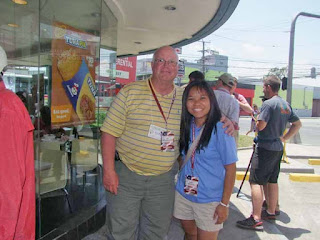During the first part of our recent tour, photographer Rogelio Santos, aka Ojie, took hundreds of photos of the group. We thought that you would enjoy seeing some of these. Below is a brief explanation of each photo we chose to include from Ojie’s file.
We first visited Santo Tomas University, where John Hogue was interned as a civilian prisoner of war with his Mother and siblings.
John Hogue and John Paul Mathews at Sto. Tomas, in front of the main building, which was used for civilian POW quarters and medical facilities
We visited Bilibid, the Manila City Jail, where several of our veterans were held for varying lengths of time.
Marcia, Lawrence Nelson, and Katie Klug walking back to the bus from the Bilibid (Manila City Jail) gate
We then went to the Manila American Cemetery.
The group in front of the memorial chapel at the American Cemetery in Manila
Marilyn Alarcon Warzecka and her husband Don at the American Cemetery, in one of the two map rooms
The next day we drove to Cabanatuan to visit the location of the largest Japanese POW camp in the Philippines. Three of our veterans had been imprisoned there, along with relatives of four others in our group. Along the way, we made a couple of stops.
Nurse Lori Vanderpool poses with children in Pampanga Province
Dr. Fred Mullinex and Maria Williams in front of Jollibee in Cabanatuan City
Veterans and descendants of veterans who were imprisoned at Cabanatuan. From left to right, Steve (father Walter), Bob Ehrhart, Jim Collier, Jim Erickson (father Albert), Linda McDavitt (father Jerome),Wayne Carringer, Culea Abraham (great-uncle Linus Marlow)
Branden Piatt, Jim Collier, and Sarah Schrag at Cabanatuan
Warren Jorgenson and JoHannah Fields at Cabanatuan
The Capas Train Station was used as the unloading point for POWs who were transported by rail from the station at San Fernando, Pampanga, during the Bataan Death March.
JoHannah with a local girl outside the Capas Train Station
Malcolm Amos’ marker is KM 110, only two from the end. We stop at it every year. Malcolm had returned to the Philippines many times, the last in 2009. He passed away last year, so we stopped in his memory.
Marcia at Malcolm Amos’s Bataan Death March Marker
Next we visited the Capas National Shrine, once known as the infamous Camp O’Donnell, terminus of the Death March. Wayne Carringer was the only Death March survivor on the tour, so he was a celebrity.
Wayne Carringer and paparazzi at Camp O'Donnell
Wayne and Christianne Martin at Camp O'Donnell
Veterans Jim Collier, Bob Ehrhart, Lawrence Nelson, Ed Knight, Wayne Carringer, and Warren Jorgenson at Camp O'Donnell
College of the Ozarks group, Camp O'Donnell
Warren being lifted into one of the actual rail cars used during the Death March, which is preserved at Camp O'Donnell
Warren in train car, Camp O'Donnell
The next day we visited the Hellships Memorial at Subic Bay. Four of our vets (five including Ray Heimbuch who joined us when we reached Corregidor) had been transported to Japan on these awful ships.
Culea Abraham reading one of the plaques at Hellships Memorial
Jim Erickson, Jim Collier, and Warren Jorgenson, at Hellships Memorial
Group photo, Hellships Memorial, Subic Bay
Shizu Maekawa and Yuka Ibuki, researchers for the US/Japan Dialogue on POWs, at Hellships Memorial
Two days later, we spent the morning at Mt. Samat, celebrating the Day of Valor with the Filipinos. Four of our veterans, those who served on Bataan, Corregidor, and Caballo, were honored with seats on the stage.
Veterans Jim Collier, Lawrence Nelson and Ed Knight with Girl Scouts at Mt. Samat
President Fidel Ramos with Jim Erickson, Linda McDavitt, and Steve, Mt. Samat
Our four Bataan, Corregidor and Caballo veterans, Mt. Samat
Warren, Yuka, and reporter Shino Tatsunori, Mt. Samat. In 2011, Shino travelled to the Philippines with Bridge for Peace, a Japanese group facilitating dialogue between WW II veterans from Japan and the Philippines. He recently graduated from college and began a job with a Japanese-language newspaper in Manila, so he was very interested to interview our veterans.
Veterans Ed Knight and Bob Ehrhart with two Filipinas, Mt. Samat
Our final stop before Corregidor was at the kilometer zero marker in Mariveles, Bataan, the traditional start of the Bataan Death March.
Wreath in honor of her father, a Philippine Scout and Death March survivor, laid by Marilyn at KM 0 in Mariveles, Bataan
Wayne at marker noting the beginning of the Death March route, Mariveles
In order to return to Manila to print photos for the tourists, Ojie left the group before we went to Corregidor. Since our seventh veteran, Ray Heimbuch, and his daughter Nora did not join us until Corregidor, they are regrettably absent from Ojie’s photos.
Steve and Marcia on the Rock





























No comments:
Post a Comment